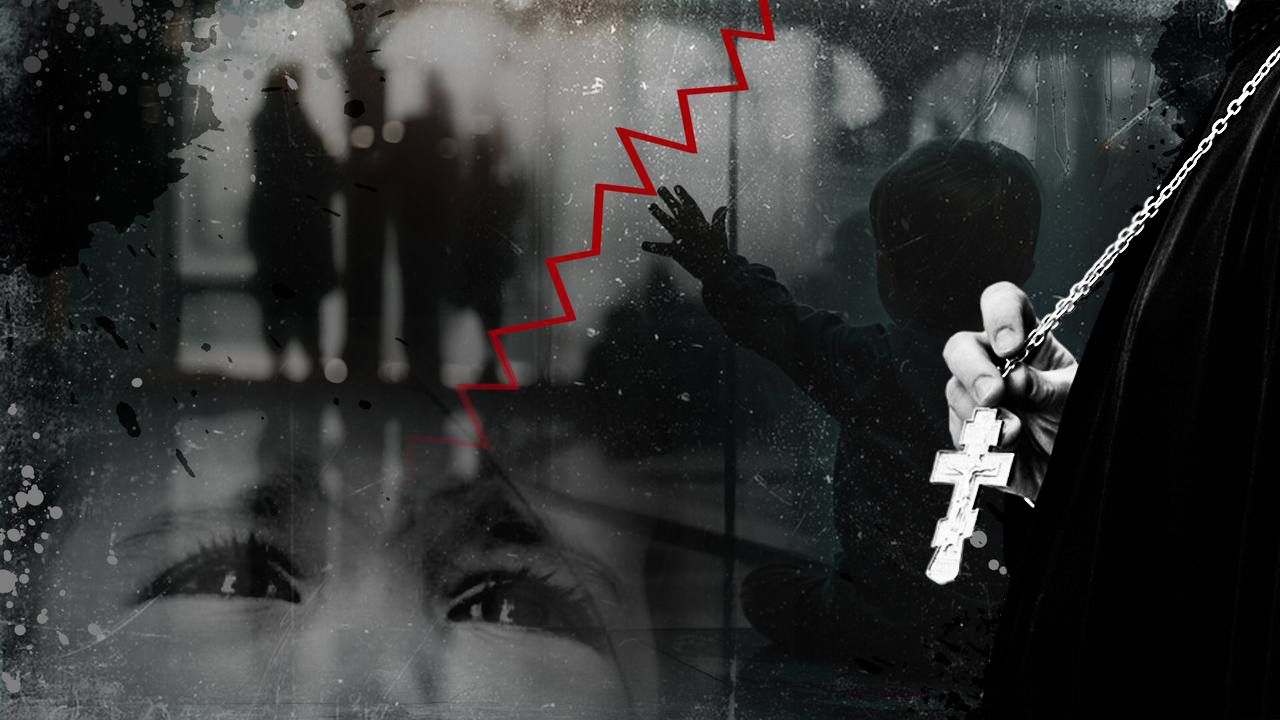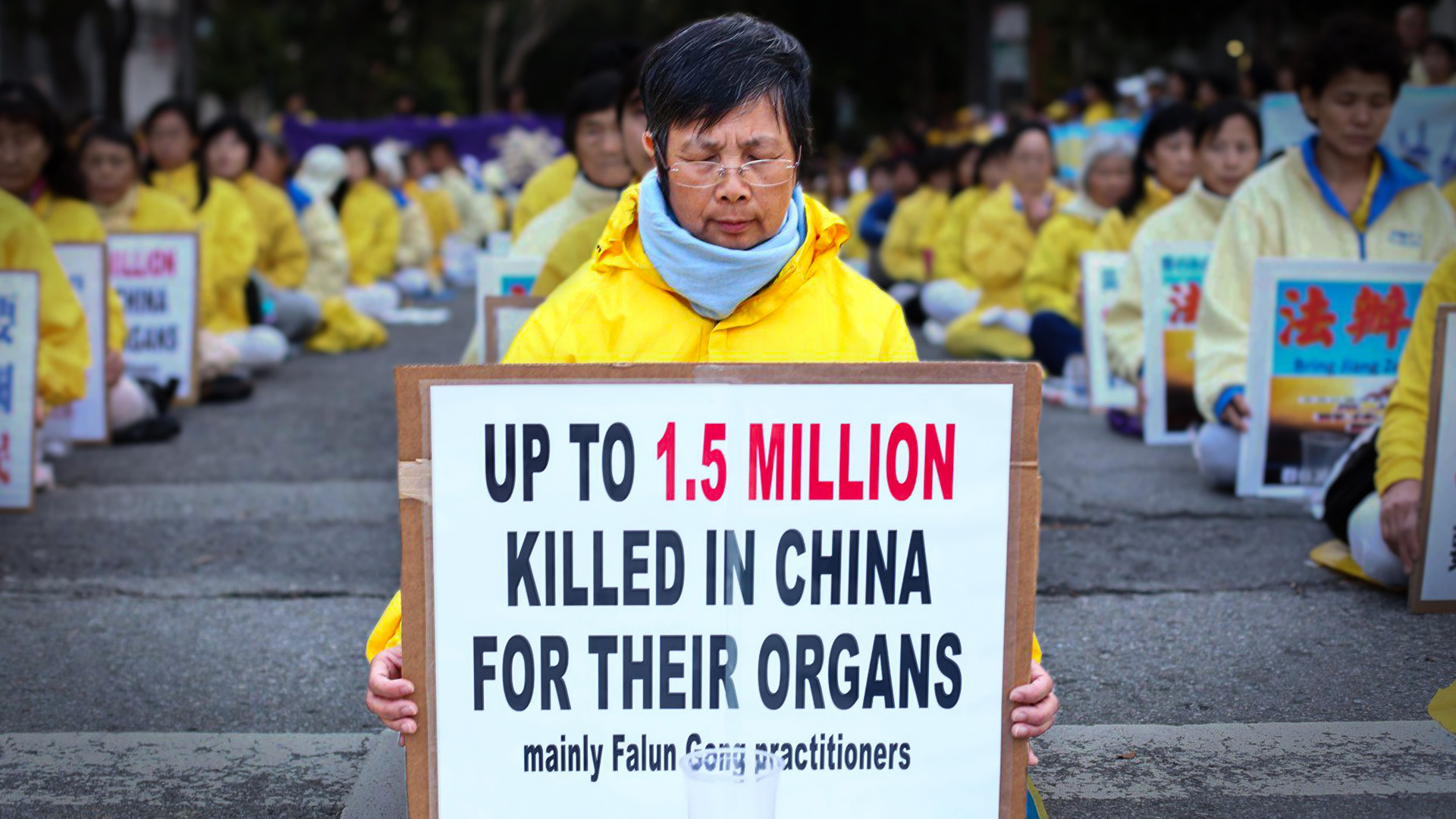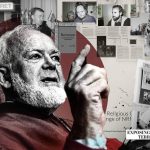Ukraine and Russia are two warring countries. In the conditions of the long-lasting bloody war, they are totally focused on antagonism, confrontation and mutual distrust. Nevertheless, a whole network of agents, which is directly controlled by the Russian organization RACIRS*, has been operating in Ukraine for many years. This agent network represents a conglomerate of several individual organizations and small groups of people, seemingly unrelated to each other. Their interconnection is exposed, among other things, through the same kind of activity aimed at destroying democratic values and conducting sabotage inside Ukraine according to the instructions set forth in detail in RACIRS’ manuals (to be cited below). We have tracked those instructions on the websites of the dioceses of the Russian Orthodox Church (ROC) whose deans are members or even leaders of RACIRS. The tasks of RACIRS agents include anti-cult activities using Nazi dehumanizing methods, carrying out all stages of genocide of undesirable groups of people, spreading slander and disinformation, manipulating public opinion, influencing legislative, executive, judicial and religious authorities, mass media, law enforcement agencies and special services.
* RACIRS is the Russian Association of Centers for the Study of Religions and Sects, founded in 2006.
Officially, RACIRS is an anti-cult organization aimed at combating undesirable religious movements, but in reality, it carries out an ideological and information warfare in the media space. RACIRS President is Alexander Dvorkin, and its vice-president is Archpriest Alexander Novopashin. Alexander Dvorkin’s teachers at one time were Johannes Aagaard and Wilhelm Haack, direct successors of the Nazi activity of Walter Künneth who headed the apologetic anti-cult center under the Third Reich. RACIRS members supervise an extensive network of subordinate organizations across the globe, while many of their agents are themselves members or directly connected with the governments in their countries. In Russia, RACIRS oversees the Federation Council that is controlled by members of the so-called secret “Diveyevo Brotherhood.” This was earlier discussed in the article “‘Diveyevo Order’: Control Center of Global Anticultism. Revival of Nazism”.
Now, let’s examine how the network of RACIRS agents operates in Ukraine.
All-Ukrainian Apologetic Center (AUAC) in the name of St. John Chrysostom
RACIRS’ official representative in Ukraine is the All-Ukrainian Apologetic Center (AUAC) in the name of St. John Chrysostom, established in 2011. Besides, the center includes local apologetic centers under many dioceses. The chairman of AUAC Board of Trustees is bishop Jonah of Obukhov (on August 17, 2017, he became an archbishop). AUAC meetings have been attended by representatives of dioceses of the Ukrainian Orthodox Church (UOC) and representatives of UOC Synodal Department for Youth Affairs.
Previously, AUAC used to have an Internet portal Apologet 1, but today we can find information about the website activity only in a stored archive. Yet, there are other websites where hectic anti-cult activities took place for a long time, up to the outbreak of the full-scale war. Since the beginning of 2022, those activities have been carried out mostly offline. Publications have only remained in the media outlets where anti-cult agents or corrupt journalists work.
An additional aspect of influence in the information field is an army of anonymous web brigades prepared by RACIRS many years earlier, which includes young online commentators with consciousness formatted by anti-cultists.



Another website related to AUAC operations is “Orthodoxy in Ukraine” 2. Currently, it is also inactive 3, but thanks to the saved web archive4, we can see their anti-cult activities:


In the VK social media, there is also a preserved page of AUAC in the name of St. John Chrysostom 5, where they either stopped publishing information a few years ago or thoroughly cleaned up the publications.

In 2017, Ukraine’s neighboring country Poland hosted the tenth Inter-Orthodox Meeting of Centers for the Study of New Religious Movements and Destructive Cults, which was attended by UOC representatives 6 for the tenth year in succession.

Apart from the chiefs of AUAC departments and priests of the dioceses, AUAC involved a considerable number of young activists and executors 7 who were recruited by RACIRS agents and in whose heads reality was deformed through anti-cult influence or, if we call things by their proper names, through special psychological conditioning of anti-cult agents’ consciousness by anti-cultists. The presence of youth created an additional effect of mass involvement in artificial formation of public opinion and helped solving technical tasks and strengthening information influence via the Internet.

Formation of a youth apologetic movement for serving in AUAC is described on the ukrsekta website 8.

Another fact is very interesting, too. While the main anti-cult center of RACIRS in Russia is the Center for Religious Studies in the name of Irenaeus of Lyon, for the Ukrainian center they chose the name of St. John Chrysostom. A question arises, however: did the one who decided to name the apologetic center after this saint make his choice consciously, or did someone give him a hint? After all, if in this way young people are supposed to join the study of the holy fathers’ heritage in order to protect their faith (as indicated in the document on the screenshot), how will the following sayings by the holy fathers, e.g. the one after whom the apologetic center is named, affect youth?
Let us present to your attention the famous St. John Chrysostom (fourth century AD), who is frequently quoted in Orthodoxy and whose words are particularly attractive to those hierarchs that support the narratives of Nazi ideologists from RACIRS:
In his Homily IV “Against the Jews”, St. John Chrysostom said the following: “Suppose someone slays another in accordance with God’s will. This slaying is better than any loving-kindness. Let someone spare another and show him great love and kindness against God’s decree. To spare the other’s life would be more unholy than any slaying. For it is God’s will and not the nature of things that makes the same actions good or bad.” These are the words by a man called a saint.
However, what did Jesus Christ teach? “You have heard that our ancestors were told, ‘You must not murder. If you commit murder, you are subject to judgment’.” (Matthew 5:21 NLT)
For anti-cultists in the church ranks, a man who calls for killing by God’s will is superior to Jesus Christ Himself. This man is the one whose will an anti-cult agent will carry out when they are ordered to go and commit murder. A question arises: what does Christianity have to do with that, and who is actually the mouthpiece of God’s will in the understanding of anti-cultists? Only ROC hierarchs may be those mouthpieces because all other religious organizations aren’t Orthodox Christian, thus not being authentic as anti-cultists like to repeat.
Here’s another quote by St. John Chrysostom from the Homily IV “Against the Jews”: “The man who struck the prophet was saved; the one who spared the prophet was punished. Why? That you may learn that, when God commands, you must not question too much the nature of the action; you have only to obey.” Yet, the will of which god must be obeyed in this case if it implies violation of one of God’s main commandments: “Do not kill!”?
It is worth immediately delving into several pages of the website ukrsekta.info 9 where you can trace how members of AUAC execute some of the instructions from RACIRS manuals. For instance, on November 24-25, 2011, a round table “Orthodoxy in Ukraine: Relevance of Modern Apologetics” was held. On March 3, 2012, the documents 10 adopted at the round table were sent to UOC Episcopate and the public, to be more precise: to all UOC dioceses, as well as to the President of Ukraine, members of the Ukrainian Parliament and executive authorities.

As a result of the meeting, six final documents were adopted:
On Assessment of Foreign Experience in Differentiating the Cultural Contribution of Religious Traditions at the National Level;
- On Introduction of Practices of the Dangerous Totalitarian Sect “Scientology” into the Ukrainian Education System;
- On Insulted Feelings of Believers and Incitement of Interreligious Strife;
- On the Relevance of Establishing an Orthodox Christian Association of Psychologists and Preventing Pseudo-Orthodox Psychological Practices;
- On Formation of the Youth Apologetic Movement;
- The Concept of Apologetic Service in Modern Ukrainian Orthodoxy.
Special attention should be paid to the document entitled “On Assessment of Foreign Experience in Differentiating the Cultural Contribution of Religious Traditions at the National Level” 11. Here’s a quote from this document: “It would be relevant if the leaders of Ukraine started working jointly with representatives of traditional religions on finding ways to optimally improve Ukrainian legislation according to European practices. Perhaps, an appropriate step could be establishing a joint commission from among representatives of legislative and executive bodies and traditional canonical religions.”
This document contains many references to the experience of European countries, but it doesn’t mention that in the vast majority of those countries anti-cult organizations have already been operating for a long period of time, being official members of the French umbrella federation FECRIS whose vice-president since 2009 was the Russian anti-cultist Alexander Dvorkin (at that time, he was already the president of the notorious RACIRS).
Yet, let’s go back to RACIRS instructions. Before giving the first example of such instructions, for comparison, let’s consider a document that presents the concept of apologetic service in modern Ukrainian Orthodoxy 12.
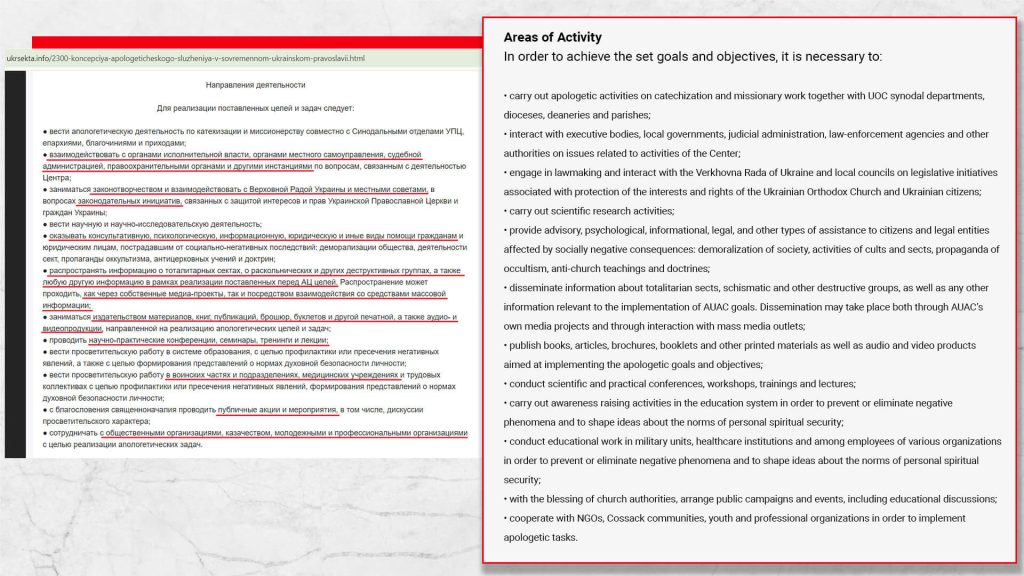
The document explicitly describes interference in public affairs of Ukrainian executive and legislative authorities. Here are some excerpts from the screenshot above:
- “interact with executive bodies, local governments, judicial administration, law-enforcement agencies and other authorities…;”
- “engage in lawmaking and interact with the Verkhovna Rada of Ukraine and local councils on legislative initiatives;”
- “disseminate information about totalitarian sects… as well as any other information relevant to the implementation of AUAC [apologetic center] goals… both through AUAC’s own media projects and through interaction with mass media outlets;”
- “publish books, articles, brochures, booklets and other printed materials as well as audio and video products;”
- “conduct educational work in military units, healthcare institutions and among employees of various organizations;”
- “arrange public campaigns and events,” etc.
Now, let’s compare these instructions with the instructions voiced by archpriest Dmitry Smirnov 13 at the anti-cult conference “Totalitarian Sects: Threat of the 21st Century” organized by Alexander Dvorkin in Nizhny Novgorod, Russia, in 2001:

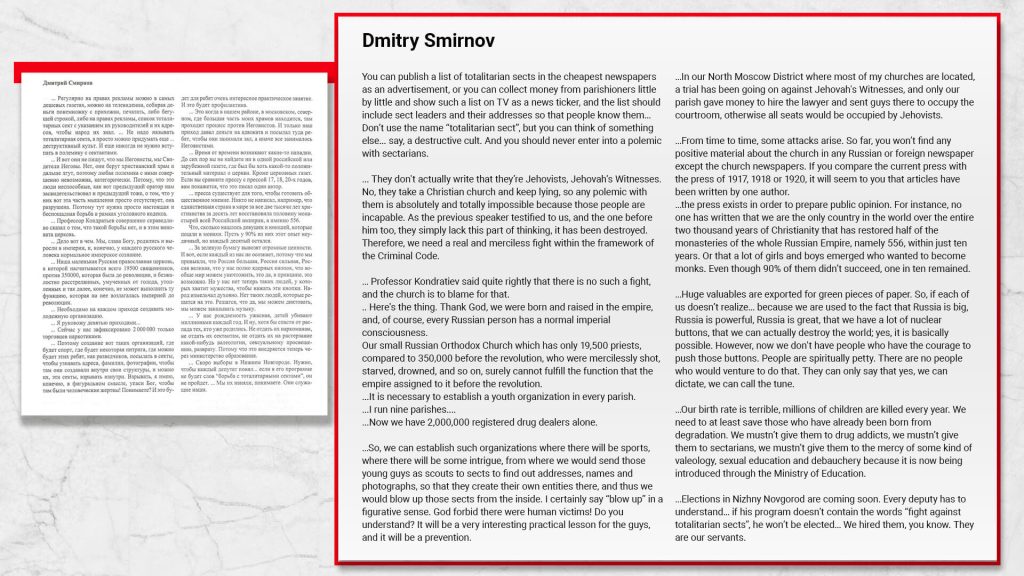
Back in 2001, Russian anti-cultists issued detailed instructions on how to counteract any undesirable organizations; how to interfere with the competences of legislative, executive and judicial bodies as well as state registration agencies; and how to violate the law, the fundamental democratic principles, presumption of innocence, pluralism of opinions and human rights. From their instructions we find out how even two individuals, using artificially formed public opinion, can ensure closure of any undesirable organization or arrange a nation-scale case.
Moreover, there are dehumanizing methods such as labeling and stigmatization of targeted organizations and people.
Implementation of these recommendations can be seen in the Ukrainian information and legislative space over the last 12 years. The flywheel of destructive impact launched by Russian anti-cultists in 2001 at the conference in Nizhny Novgorod ultimately gained momentum in Ukraine 10 years later and hasn’t stopped to this day. It is even pointless to comment on some of the statements in the conference records:
– “Every deputy needs to understand that if their program doesn’t include the words ‘fight against totalitarian sects,’ they won’t succeed. We hired them, you see. They work for us.”
– “Thank God, we were born and raised in an empire, and of course, every Russian person has a natural imperial consciousness.”
– “It’s necessary to establish a youth organization in every parish… So, creating such organizations where there’s sports, some intrigue, and where we can send these guys, like scouts, into sects to gather addresses, names, and photos, so that they can create internal structures and blow up these sects from the inside.”
– “… We are used to the idea that Russia is vast, Russia is strong, Russia is great, and that we have plenty of nuclear buttons, that we could destroy the world if we wanted. Yes, theoretically, it’s possible. But we no longer have people with the courage to push those buttons. Our people have spiritually diminished. There are no longer individuals who would dare do it. Dare to say, yes, we can dictate, we can call the tune.”
– “‘Names and addresses.’ Two people in any city can easily find out the names, patronymics, addresses, and home details of all the leaders of existing sects. …You can photograph them as they leave their homes. Let every city resident know their faces, first and last names, patronymics, home addresses, and phone numbers… and let them continue to live like that.“
This was how the Nazis operated once, and today, nothing has changed. By the way, it wasn’t just the Nazis — this was also how the Bolsheviks operated.
RACIRS Agents in UGCC (Ukrainian Greek Catholic Church)
The above is just one of many examples that convey the true goals of anti-cult organizations. Not only the AUAC in the name of St. John Chrysostom, organized under the UOC, followed RACIRS’s instructions. The implementation of these instructions can be traced in another Christian denomination in Ukraine — the UGCC (Ukrainian Greek Catholic Church). Let us present an example from Halyna Bilak’s study, “Specifics of using PR technologies in the communicative activities of the ‘Dohnal Sect’ and UGCC’s anti-sectarian campaign” 14.
The first and obvious feature of this document is the use of the Nazi method of branding with dehumanizing labels like “sect” and “cult.” It should be noted that these stigmas were coined into the information field in the former USSR countries in 1993 by Alexander Dvorkin, a disciple of Johannes Aagaard, who continued the activities of Nazi ideologists.
The document begins with the following statement: “One of the problems that is particularly evident today, and that requires the use of PR tools by the Churches, is the spread of various sects (cults) in Ukraine.” It then mentions organizations such as “Embassy of the Blessed Kingdom of God,” “Jehovah’s Witnesses,” and “The Unification Church.” In this way, another method of Nazi anti-cultists and Hitler himself 15 — the method of guilt by association — is tacitly implemented.
*After the failed assassination attempt of July 20, Hitler invoked the ancient tradition known as Sippenhaft to punish the crimes of those considered traitors. With Sippenhaft, a person could be guilty simply by association. Starting with those connected to the failed attack, family members, friends, and colleagues of the conspirators were also held responsible. This tradition was used to justify the imprisonment and sometimes murder of thousands of people.
Special attention in this work is given to the so-called “Dohnalites,” or the UOGCC (Ukrainian Orthodox Greek Catholic Church). The document further notes that the problem is not only about legislative regulation of the “cults” issue, but primarily about how to counter them effectively.
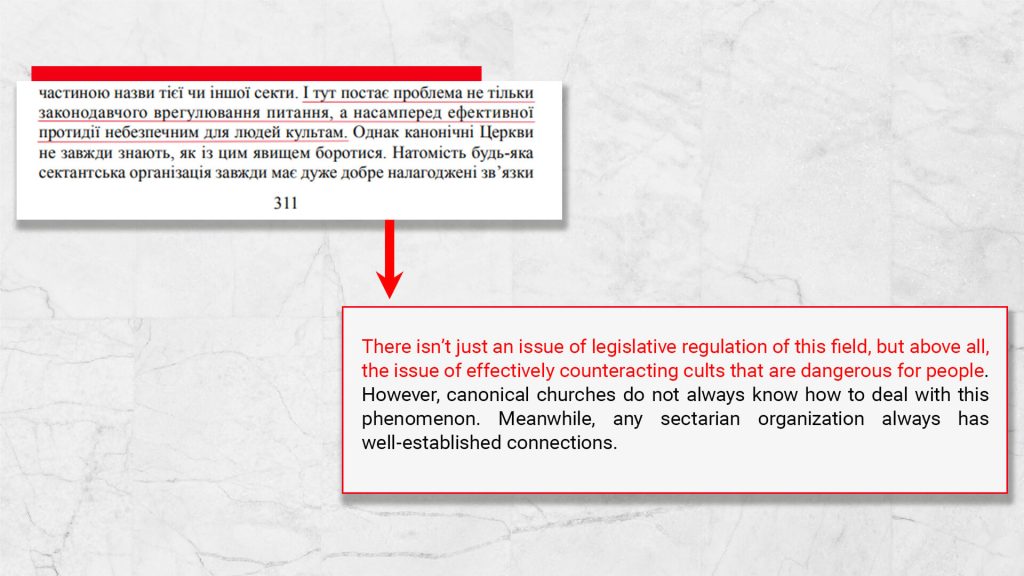
Afterwards, detailed instructions are provided to the canonical churches in Ukraine, particularly the UGCC (since the document directly concerns it), outlining what actions they should take and how to counter unrecognized non-canonical organizations, which are deliberately dehumanized in the document with the derogatory labels of “sect” and “cult”.

Being true masters of information warfare, RACIRS agents did not forget to mention in their recommendations an important aspect of informational influence on public consciousness – the importance of anti-sectarian publications in mass media:
“…anti-sect PR should primarily be the responsibility of church structures, as well as denominational and interdenominational organizations, which are obliged to systematically and purposefully spread information about a particular sect and warn the faithful about its activities. Equally important is the so-called spontaneous PR, which involves the publication of various awareness raising materials in the mass media.”
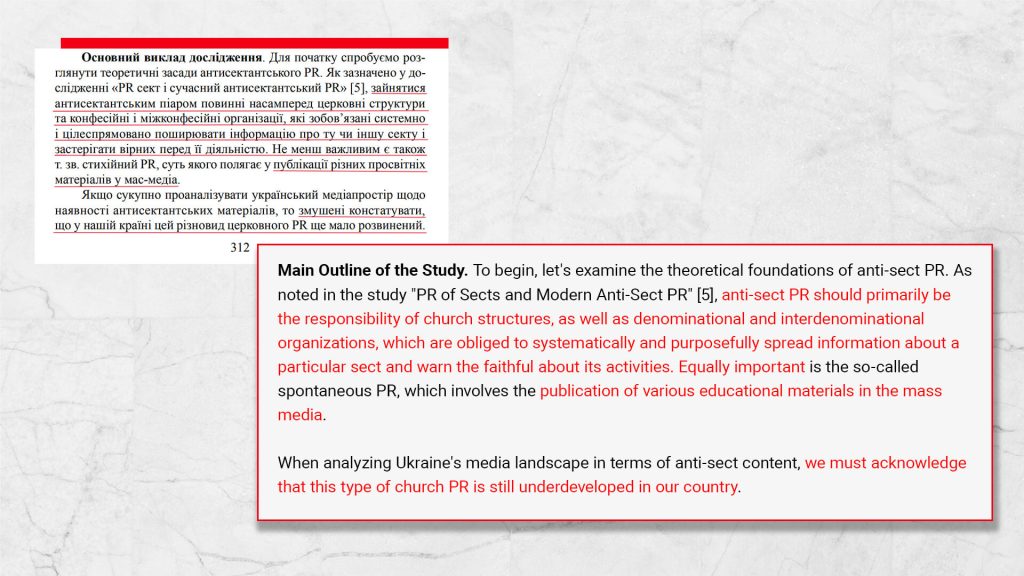
Interestingly, this document, addressed to the UGCC cites the work of Russian anti-cultists as an example of effective and successful anti-sect activity. Not only are they held up as an example, but their media projects and active internet campaigns are specifically highlighted. This is despite the fact that the UGCC, throughout its entire historical existence, has positioned itself as a unifying force for the Ukrainian people, filled with patriotic views and loyalty to Ukraine. Apparently, this didn’t prevent embedded agents from providing a list of Russian projects and anti-cult centers, conveniently “forgetting” to mention RACIRS itself. By that time, all anti-cult activities in Russia, including centers and projects, had been long overseen and controlled by RACIRS. As we can see, their narratives, guidelines, and instructions became deeply ingrained in the work of anti-cult agents in Ukraine, and the results of their efforts are still evident today.

For example, the website antiCEKTA.ru 16 mentioned in the document is the Saratov branch of the Center for Religious Studies in the name of Irenaeus of Lyons, whose founder and president since 1993 is Alexander Dvorkin (who is also the president of RACIRS).
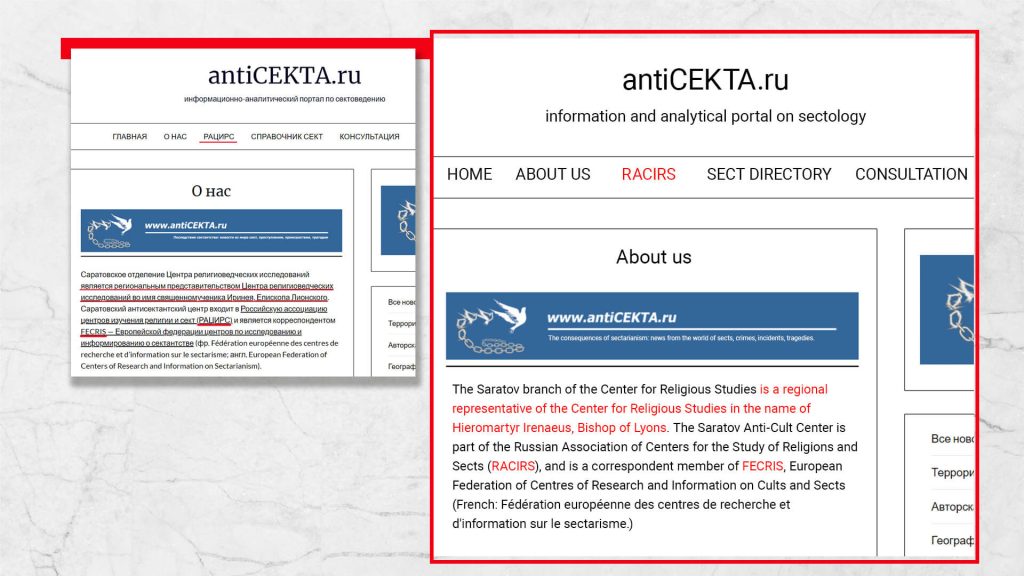
Or, for instance, another mentioned Russian anti-cult center, sektainfo.ru, provides a list of centers for information on sects, with a reference to RACIRS. In the “Library” section, it features anti-cult literature, including works by Alexander Dvorkin and American Steven Hassan. It appears no one was concerned that RACIRS, a Russian organization, was being held up as an example for Ukrainian traditional churches, in this case the UGCC. By 2012, RACIRS’ activities had already incorporated not only anti-sectarian rhetoric but also anti-Ukrainian and anti-democratic rhetoric. Its agents had long been spreading disinformation and conducting covert sabotage in Ukraine. Moreover, RACIRS agents had already been spreading the narrative that the first Maidan in Ukraine in 2004 was organized by “sectarians” and that “sectarians” were among its ranks.
Returning to the document “Specifics of using PR technologies in the communicative activities of the ‘Dohnal Sect’ and UGCC’s anti-sectarian campaign,” several “recommendations” concerning Ukrainian anti-sect activity are also provided.
Point 1 states, among other things, that efforts should “focus on publishing expository materials that help solidify a negative image of sectarian groups. Special attention should be given to the targeted nature of the journalism, which should address both believers and non-religious people.” In other words, the goal of anti-cult organizations is to create and cement a deliberately negative image of undesirable groups in society, regardless of the actual facts, activities, or values within these organizations. Simply put, anti-cult “nazis” have for many years dehumanized citizens of their countries, violating the presumption of innocence with their branding and baseless accusations, and destroying the lives and futures of countless people.
This activity is a real act of sabotage within the country, undermining its integrity and waging a covert ideological war. How else can one describe the undermining of the rule of law, the Constitution, and the democratic principles that are the foundation of a free and just civilized society? This is nothing less than a return from civilization to the darkness of dictatorship and totalitarianism.
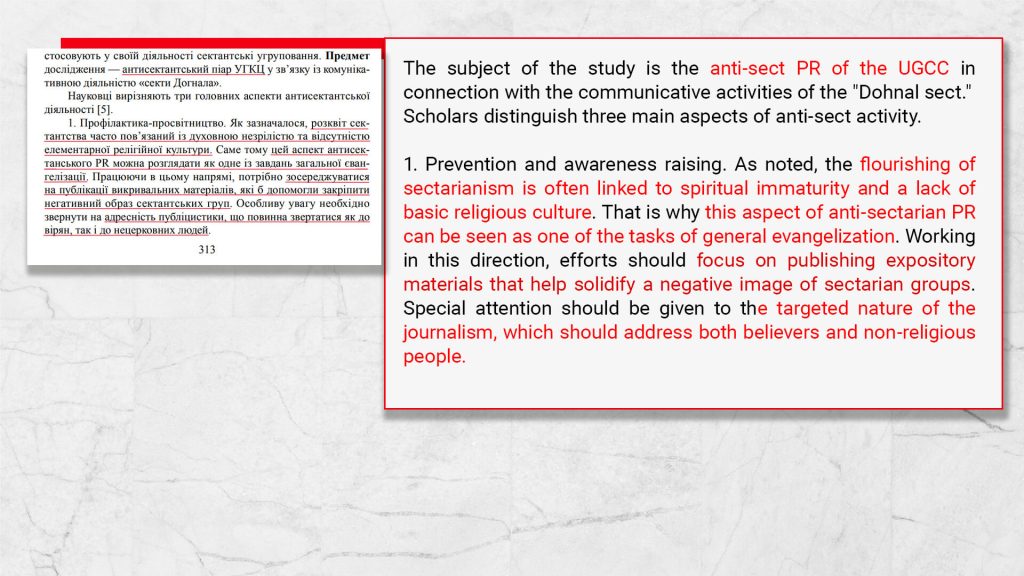
Let’s specifically highlight point 2: “Rehabilitation of Former Sect Members.” This is a favorite and key method used by anti-cultists—availability of “victims” who need protection. And if no victims exist, they start looking for them. This issue has been previously addressed in the article “The Role of Apostates in Anti-Cult Organizations: Creating the Fake Victim.”
In point 3, we once again hear RACIRS’ directive to influence government authorities. It begs the question: Who are these people who believe they have the right to dictate to the governments of any country and seize control of the informational space in any nation? What kind of authority over authority is this?
Further down, in another excerpt from the document, we see the same instructions: “The UGCC’s allies in this matter can and must include government authorities, Christians of other denominations, journalists, law enforcement officers, educators, doctors, and others.” Just as anti-cult nationalism began spreading in Russia in 1993, by 2011-2012 it had fully infiltrated Ukraine. Similarly to how RACIRS representatives infiltrated other denominations (such as the same AUAC (UOC) and its dozens of diocesan apologetic centers), the UGCC is also urged to establish a head information and consultation center and similar regional offices.


It has also been observed that before 2011, there were already anti-cult publications in Ukrainian media 17, 18 that used dehumanizing labels like “sect” and “cult” and mentioned RACIRS leaders (e.g., RACIRS Vice President Archpriest A. Novopashin) 19. Interestingly, in 2004, another anti-cult conference titled “Totalitarian Sects and the Democratic State” was held in Novosibirsk. Among the 612 registered participants, there were also citizens from Ukraine. Moreover, 2006, the year RACIRS was founded, marked the consolidation of all Russian regional anti-cult centers under this organization and the intensification of anti-cult activities in neighboring countries. In addition to these factors, another reason for the emergence of such publications in the Ukrainian media space was the need for informational processing of the population, preparing the ground, creating the appearance of a problem and danger, in other words, creating the illusion of the need for anti-cult organizations in society.
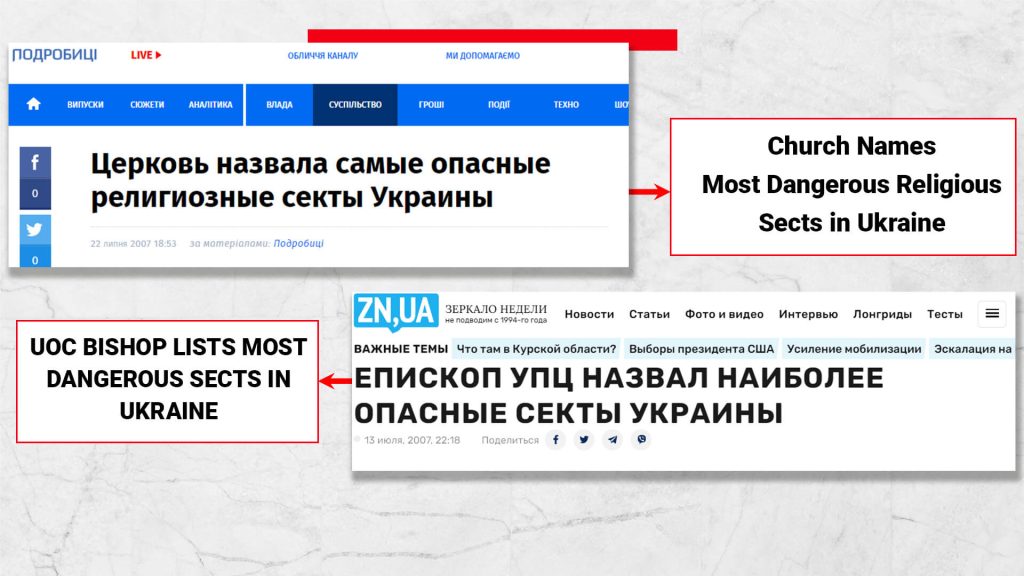

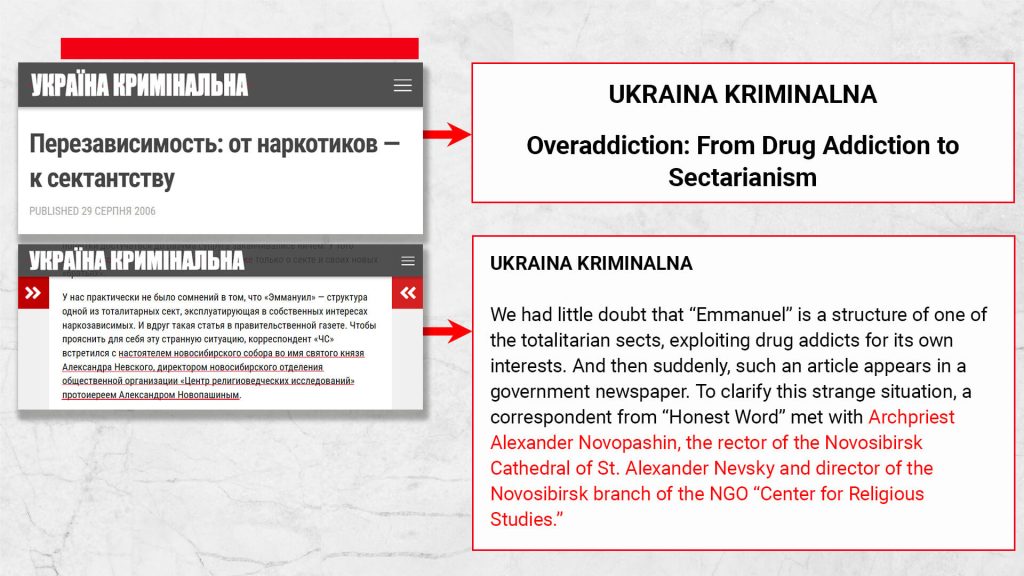
The last screenshot provides information from the news portal “UKRAINA KRIMINALNA” featuring an interview with Alexander Novopashin (Vice President of RACIRS). In addition to publications with RACIRS leaders, this portal also published an interview in 2008 with Friedrich Griess, then President of FECRIS*.
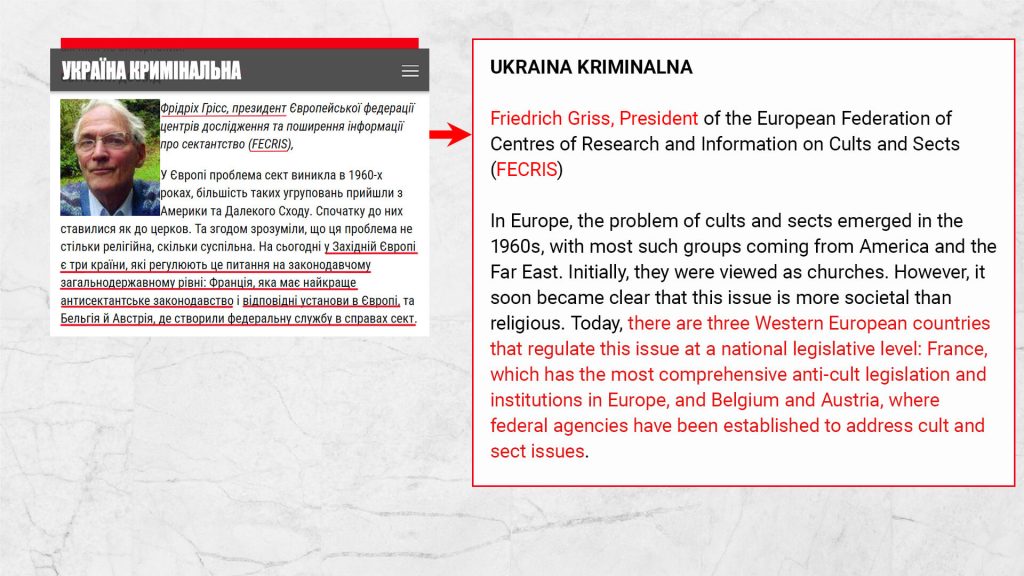
* Friedrich Griess was the president of FECRIS until 2009. In 2009, Thomas Jeffrey Sackville was elected as the new president during a meeting in St. Petersburg, Russia.
Hidden Connection Between Ukrainian Anti-Cultists and RACIRS Amid Publicly Anti-Russian Stance. Anti-Cult Tactics of the Bolsheviks: Exploiting Current Military and Political Contexts
In the rhetoric of contemporary Ukrainian anti-cultists, one particular trait is noticeable, suggesting the use of methods reminiscent of those employed by the Bolsheviks during religious repressions. For instance, consider another excerpt from the previously mentioned document addressed to the UGCC, which refers to the “Dohnalites”:
“It is important to note that the UGCC not only denies the accusations from the ‘Dohnal sect’ or refutes them but also attempts to understand the reasons behind the emergence of such a movement. For instance, in the aforementioned interview, Father O.-D. Vilchynsky answered the journalist’s question about who benefits from this…” and then continued with such accusations as:
- “[beneficial to] Moscow’s geostrategists…”;
- “another attempt to split the UGCC was made — through an intelligence agent of the former communist Czechoslovakia…”;
- “we have a new cult… a Moscow-philic cult… extremely radical and militant”;
- “…they are a combat unit of the same ‘Russian World’” and so on.

Among the methods used by anti-cultists, both current and Soviet, is the patterned approach of accusing groups of collaborating with foreign countries or working for their intelligence services. In assigning such espionage-related allegations, a key factor for Soviet anti-cultists was the recent or ongoing negative historical experience of the population living in the territory where the anti-cult propaganda was being launched.
The countries allegedly supporting these so-called “cults” were chosen based on the national audience to which the propaganda was addressed. For example, the Ukrainian-language journal “Bezvirnyk” (“A faithless man”) (1925-1935), published in Kharkiv, had key rhetorical differences from other anti-religious propaganda journals 20 such as “Bezbozhnik u stanka” (“The Godless at the Machine”) (1923-1931), “Bezbozhnik” (“The Godless”) (1925-1941), and “Antireligioznik” (“Anti-Religionist”) (1926-1941), which were published in Moscow. Due to recent Polish-Ukrainian confrontations, “Bezvirnyk” (“A Faithless Man”) introduced narratives claiming that “sectarians” were working for Poland. This was a quick way to tarnish undesirable organizations by invoking recent strained relations between the two peoples, casting Polish counterintelligence as the patron of these movements according to Bolshevik propaganda. In other words, the choice of a “patron” country for the stigmatized religious movement was based on the audience’s historical experience of conflicts with other countries, rather than actual collaboration or lack thereof. The selection was made based on what was relevant and alive in the local population’s consciousness.
In other regions of the USSR, a global enemy and patron of the “cults” was often portrayed as the United States or Great Britain. For audiences in specific territories, the “sectarian friends” were countries like Germany (due to the lingering memory of World War I in the 1920s and 1930s), Romania, and Sweden (mentioned in the journal “Bezvirnyk”), as well as Denmark and the Netherlands (in the journal “Antireligioznik”).
In other words, the choice of the patron country for stigmatized organizations was largely irrelevant to global anti-cultists, much like the specific Christian denomination or religion used against them. Similarly, anti-cultists did not care which political force they used as their puppet, whether Bolsheviks or Nazis. Their primary goal across eras was to divide, clash, and control, manipulating chaos and deceit to further their global objectives while covering their tracks.
Other countries that Bolshevik propaganda associated with “sectarian” patronage included Japan and Italy. These countries appeared alongside Germany in propaganda journals of the 1930s as global events pointed to imminent attack by Hitler. During this time, fascism and Nazism were spreading, and preparations for a new global war were underway, which anti-cult forces within the Bolsheviks exploited to strengthen their repressive mechanisms within the USSR.
In essence, organizations labeled as “sects” or “cults” in Bolshevik propaganda journals were portrayed to the masses as collaborators with invaders encroaching on sovereign territories and as agents of foreign states. In reality, modern anti-cultists use similar methods, but these tactics are now applied not only in print media and communication channels but also in the online space.
!["Bezbozhnik u stanka" (No. 6, 1929) [The Godless at the Machine]. Image from the website "Historians," dedicated to Ukrainian history.](https://actfiles.org/wp-content/uploads/2024/09/30-31-1024x576.jpg)
It is also important to clarify that these anti-religious journals were originally written with negative, disparaging connotations and served a stigmatizing function. Soviet propagandists who created these articles and the editors of these journals did not know the true facts and made no effort to find out. The information was presented in such a way that it was impossible to confirm or refute, though in reality, no one made an attempt. The general line, with its embedded narratives of anti-cultists, played a dominant role among the public, and everything was accepted on blind faith.

Anti-cultists among the Bolsheviks created an entire system of dehumanizing stereotypes. These stereotypes are still used in the narratives of contemporary anti-cultists, including those from Ukraine, just as Nazi-era legacies of Walter Künneth, who led the Apologetic Center under the Third Reich, are perpetuated. It turns out that modern agents of RACIRS, whether operating in Russia, Ukraine, or elsewhere, are executing old directives from anti-cult ideologists involved in the creation of two totalitarian regimes: Hitler’s Nazi Germany and the USSR.
Anti-Cult Power Destroying Lives, Killing Children, Colliding States
The paradox of the 1920s and 1930s is that similar anti-cult activities were simultaneously carried out in two distinct countries with different cultures, different ruling elites, different ideologies, and different religious situations. Despite their vastly different political, social, and religious contexts, persecution of dissenters was carried out with identical methods, as if by blueprint. Initially noble goals articulated in the ideologies of these countries in the early 1920s were by the end of the decade distorted and exploited by anti-cult ideologists, revealing clear signs of the development of totalitarianism. By the 1930s, the world witnessed the final establishment of two of the most brutal totalitarian regimes, with a peak in bloodshed and repression against their own people. Since 1939, the apex of suffering and loss of life provoked by anti-cult ideologists spread across the globe with the onset of World War II, which saw Germany invade the USSR two years later. Interestingly, behind both forces, in the negative manifestations known in history, were precisely the anti-cultists, representatives of Apologetic Centers, the true ideologists of extreme repression in any form of totalitarianism, whether it be Nazism, Red Terror, or anything else.
Analogues of Bolshevik Anti-Cult Propaganda Narratives in the Rhetoric of Contemporary Russian and Ukrainian Anti-Cultists from RACIRS
Soviet propagandists labeled members of organizations branded as “cults” and “sects” as akin to a disease, referring to them as sick people, “religiously and nervously mutilated,” and described their activities as a feverish illness. Additionally, they emphasized the material dependency of these supposedly deranged individuals on supposedly money-hungry, enslaving organizations.
“Socially dangerous people must not be allowed to hide behind religion and harm those who fall into their material dependency. Fanatical nests must be cleared out.” — I. Malyshev, “Cult Fanaticism” (The Godless, No. 6, 1931)
Let’s compare this rhetoric of disease and material dependence, characteristic of contemporary anti-cultists from RACIRS:
“The day before, on 12 May 2008, Alexander Dvorkin had told the China Association for Cultic Studies about Falun Gong:
‘They would turn individuals into tools of cults, and destroy their families. Cults harm individuals, families, societies and countries like ‘cancerous cells’ in a healthy body. Cults make no contribution to the society. But they kept absorbing human resources and wealth from it. Like cancerous cells, they obtain nutrition from the healthy body of society until it collapses’” 21.
“‘This, of course, is noxious. [On opening of a Church of Scientology in Moscow] It‟s a sort of a center of cancer tumor amidst our country and in the center of Moscow. Therefore everything possible must be done in order to prevent it.’ – A.L. Dvorkin 3rd TV Channel, Russian Viewpoint show, 2006 (RELIGIOUS EXTREMISM OF ALEXANDER DVORKIN Research Article November 2010 21-22 p.)” 22.
President of RACIRS, Alexander Dvorkin, made these statements in 2006 and 2008. A year later, in 2009, an article was published in which a similar rhetoric was voiced by the Ukrainian anti-cultist and noted Ukrainian sectologist Viktor Chernychev 23, who described cults as a cancerous tumor in society and mentioned the financial profit of the leaders of these branded organizations through the contributions of their followers.
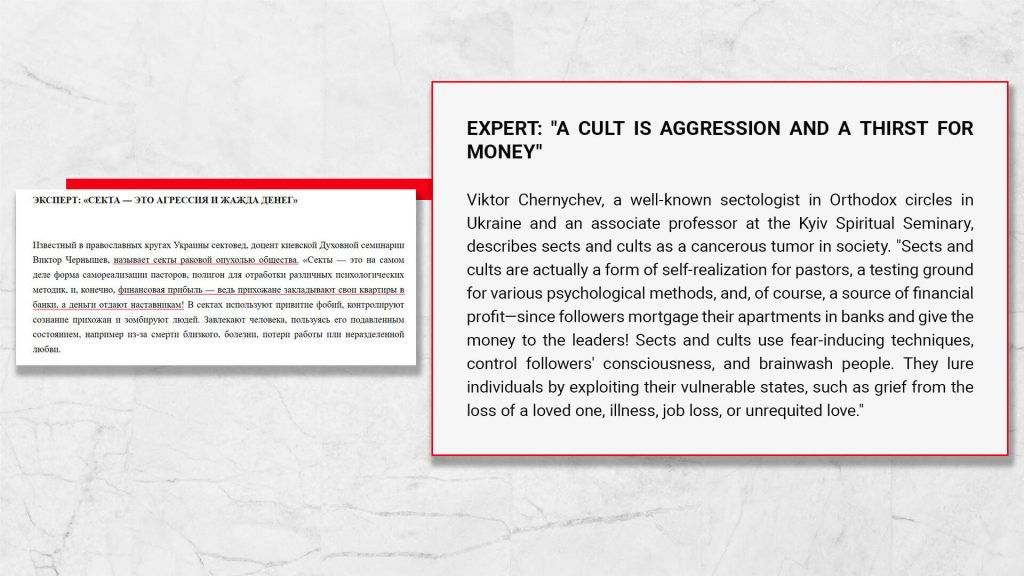
FECRIS Branch in Ukraine: Family and Person Protection Society (FPPS)
Interestingly, the anti-cult movement in Ukraine appears to be divided into religious and secular branches, with one stemming from RACIRS and the other from FECRIS*.
*It should be recalled that Alexander Dvorkin was both the president of RACIRS (from 2006 to the present) and the vice president of FECRIS (from 2009 to 2021). After stepping down from his position as vice president of FECRIS, he remained a member of the FECRIS Board of Directors for a significant period.
The FECRIS branch in Ukraine is the secular anti-cult organization known as the Family and Person Protection Society (FPPS). FPPS is mentioned on the official FECRIS website 24, 25. The president of the Family and Person Protection Society (FPPS) is Vladimir Petukhov.
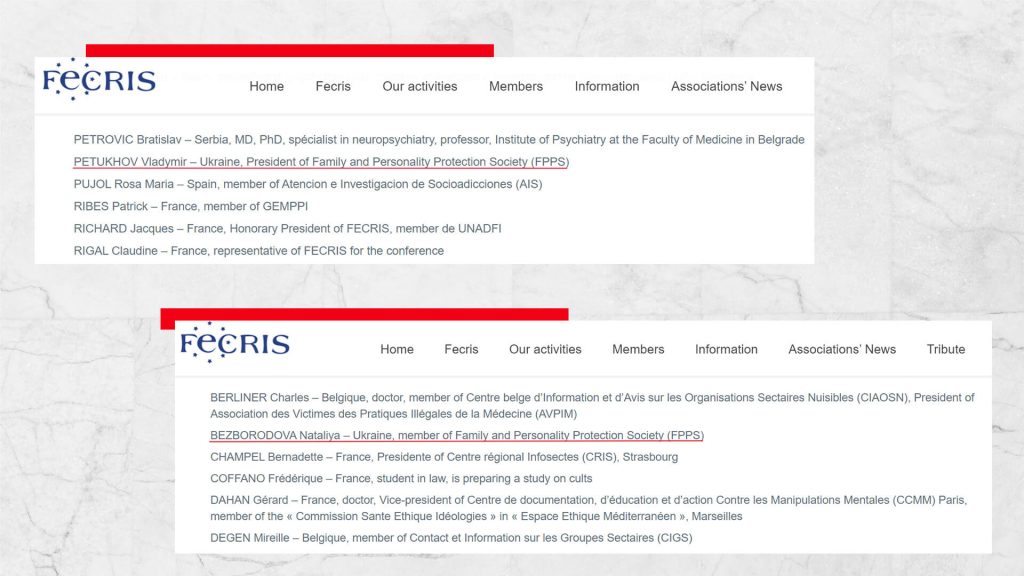
The spokesperson from the Ukrainian branch of FPPS is Evgeny Volkov. Information about this anti-cultist can be found on his website 26. In fact, Evgeny Volkov largely fulfills the role of a liaison:
– Spokesperson for the Ukrainian anti-cult organization FPPS
– Long-time member of the European federation FECRIS
– Former member of the International Cultic Studies Association (ICSA)
– Published detailed information about the “Totalitarian Sects — Threat of the 21st Century” conference (Russia, 2001) and his participation in it on his website
– Evgeny Volkov is an associate of Alexander Dvorkin
– Previously completed a dissertation under the supervision of Vladilen Izraitel (father of the current First Deputy Head of the Administration of the President of the Russian Federation, Sergey Kiriyenko)
– Liaison for other anti-cult organizations worldwide, including anti-cultists from the United States.
This is far from a complete list of Evgeny Volkov’s “achievements” and “accomplishments,” which can be found in publicly available sources.
From Evgeny Volkov’s website, we also learn that, in addition to representatives from the UOC and UGCC, there is another Protestant anti-cult center in Ukraine: the Center for Apologetic Studies.
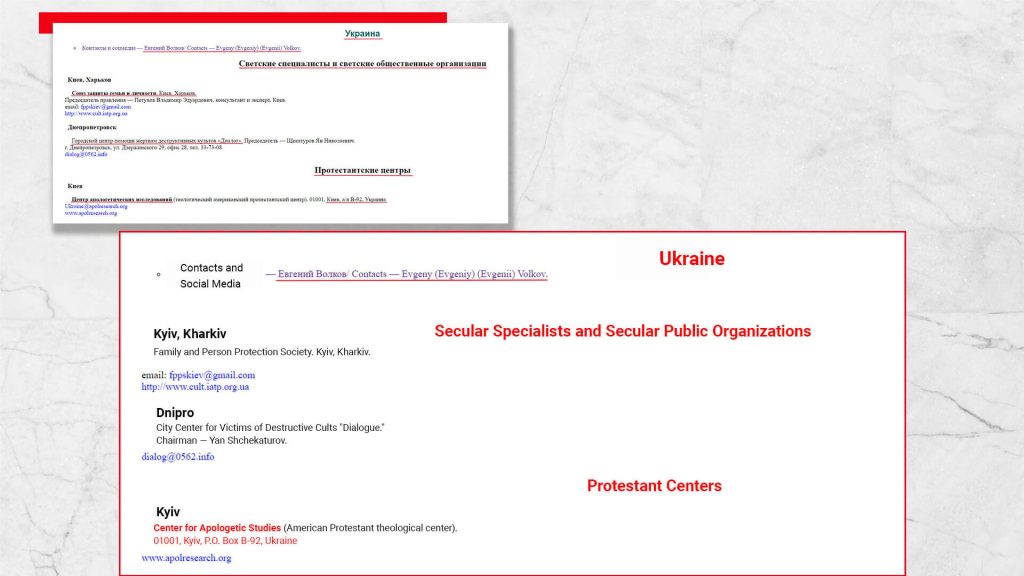
Another secular anti-cult center in Ukraine is the City Center for Victims of Destructive Cults “Dialogue,” headed by Yan Shchekaturov since 2003. The Ukrainian anti-cult organization “Dialogue” became a member of FECRIS in 2009, the same year Alexander Dvorkin became vice president of FECRIS. This information is also published on the “UKRAINA MOLODA” (“Young Ukraine”) portal 27.
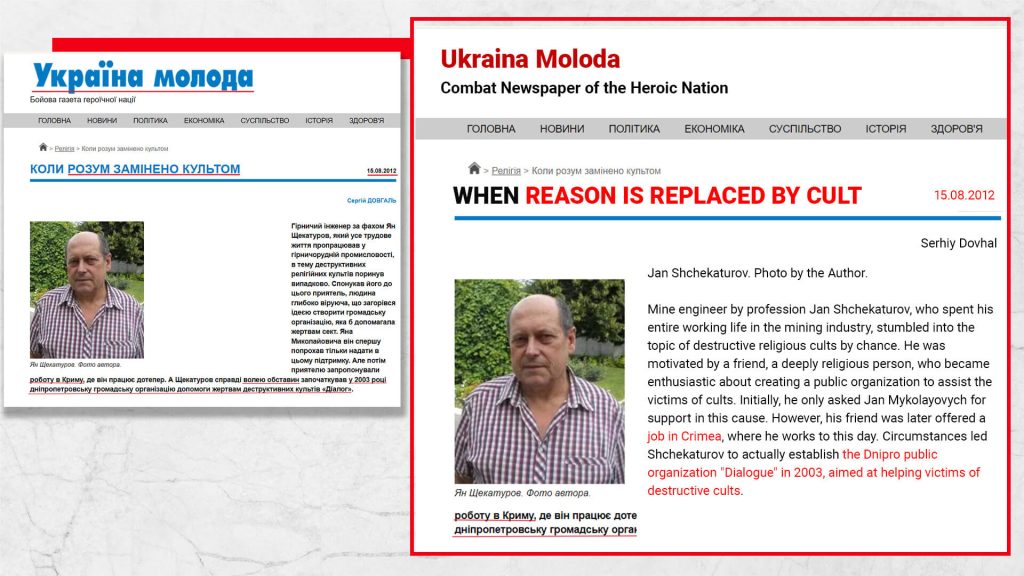
Yan Shchekaturov, in his narrative, relies on Europe (as mentioned in the article on the “Ukraina Moloda” portal) and seemingly implies that he does not accept the derogatory term “sect,” as it was used by A. Dvorkin. However, he labels similar groups with the derogatory term “cult.” Furthermore, this anti-cultist fails to mention that he has also published on the APOLOGIST website—the official site of All-Ukrainian Apologetic Center (AUAC) in the name of St. John Chrysostom (RACIRS).
In an interview, Yan Shchekaturov stated: “…in Europe, the importance of the problem was recognized over 20 years ago. Currently, in Belgium, France, and Germany, special units have been established within the police, gendarmerie, and prosecutor’s offices, tasked with monitoring the activities of destructive cult groups. Meanwhile, here, this issue is flourishing…
The main problem regarding the activities of cult groups that I have encountered lies in the inaction of the controlling and law enforcement agencies, which are obligated to expose all violations. No one wants to do anything. After six years of close communication with the prosecutor’s office and the police, I have concluded that there are only a few professionals among the staff,” — meaning, in the opinion of this anti-cultist, only a handful are willing to serve RACIRS?
Let us return to the previous anti-cultist, Evgeny Volkov. Below are screenshots taken from Evgeny Volkov’s website, where he published an article 28 about the conference “Totalitarian Sects — A Threat of the 21st Century,” organized by Alexander Dvorkin in 2001. Excerpts from it were referenced earlier in this article. Among the foreign speakers listed is Johannes Ogord, who was also mentioned in this article as a mentor to Alexander Dvorkin.

Another foreign speaker listed on Volkov’s website is Alain Vivien, a French politician and member of the Socialist Party, best known for his role in the fight against sects. From 1997 to 1998, he was the chairman of the French anti-cult organization CCMM. In 1998, he transferred this position to his wife and took the lead of another anti-cult organization MILS (later restructured into MIVILUDES) under the French Prime Minister, which addressed sect-related issues. In April 2001, Alain Vivien attended a conference in Nizhny Novgorod organized by A. Dvorkin. Coincidentally or not, but shortly after this, on May 30, 2001, the French Parliament passed the anti-cult About–Picard law, essentially allowing state-level sanctions against organizations labeled by anti-cultists. This very law has since been frequently referenced by many Ukrainian anti-cultists as a prime example of government support for anti-cult activities by a European state, while conveniently failing to mention their close cooperation with Russian anti-cultists.
Allain Vivien resigned in June 2002, but his connections and influence in the anti-cult sphere remained solid strong, as did the ongoing fight against undesirable organizations. Both CCMM and MIVILUDES continue to be members of the umbrella federation FECRIS to this day.

Among the Russian speakers, the first on the list is Archpriest Dmitry Smirnov, we cited excerpts from his speech earlier in this article; Alexander Dvorkin, the leading sectologist in Russia, and Evgeny Volkov himself (listed as number 11), an expert on psychological violence. One can assess Evgeny Volkov’s expertise based on his skills in influencing human consciousness and the subconscious. Previously in the article “Anti-cult Orders Established On Children’s Blood,” we mentioned his demonstration of techniques for exerting psychological influence on individuals.
Italian sociologist of religion Professor Massimo Introvigne makes an interesting reference to FECRIS and FPPS in BITTER WINTER, the journal on religious freedom and human rights 29:
«It is also interesting that even after the Marseille assembly FECRIS lists among its members … the Ukrainian F.P.P.S. – Family and Personality Protection Society, listed as “dormant” because of the war. A leading member of this Ukrainian group is or was Vladimir Nikolaevich Rogatin, who became notorious for launching as early as 2014, through Russian media, the ideas that Ukraine was plagued by Satanism and that the Maidan anti-Russian revolution and the defense of Crimea against the Russian invasion had been infiltrated by Nazis and neo-Pagans, both key tools of Russian anti-Ukrainian propaganda (in the latter article, Rogatin was introduced as “a correspondent member of the FECRIS”)».
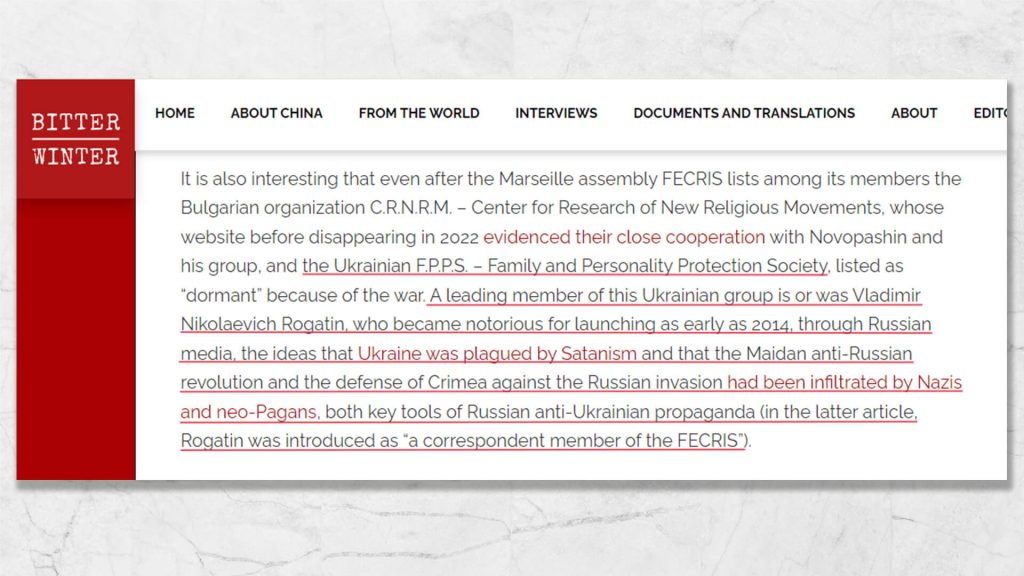
The year 2014 marked the beginning of military conflict in eastern Ukraine. This was preceded by the Revolution of Dignity, which started in 2013, and anti-cultists from RACIRS were among the first who criticized it. Interestingly, the two periods of revolution in Ukraine coincide with an intensification of anti-cult activities in Ukraine, including at the legislative level.
Attempts to promote anti-cult legislation in the Ukrainian Parliament
Previously, in the article “Diveyevo Order: Control Center of Global Anticultism. Revival of Nazism,” we noted that in 2004 and 2013, prior to the Ukrainian revolutions, there were attempts to advance anti-cult legislative proposals in Ukraine. In 2020, Ukrainian scholar and religious expert Dr. Lyudmila Filippovich commented 30 on yet another effort to push a new “anti-cult” bill in Ukraine:
“I was asked how I view the proposed ‘anti-cult’ bill. I have been observing this for more than a year. Such attempts have occurred before, and we managed to fend them off in a timely manner… I remember it was the case in 2004 before the revolution, and in 2013 as well. There is a very clear pattern: as soon as there are any problems, they immediately appeal to this topic, believing it can distract the working people from pressing issues.”
“I perceive this current initiative (of the anti-cult bill) as yet another manifestation of hybrid warfare. I see here — without being a proponent of conspiracy theories — an obvious ‘hand of Moscow,’ pardon my language. After all, they have repeatedly tried to push through a similar law there in order to ban all religions except the Moscow Patriarchate. And this initiative is nothing more than ‘clumsy mimicry.’“
News about this anti-cult bill in Ukraine was published in Ukrainian media in July 2020. Coincidence or not, two months earlier, on May 29, 2020, a Presidential Decree was issued in the stronghold of RACIRS — Russia — approving a new version of the Strategy for Countering Extremism in the Russian Federation until 2025 31, 32. Although the term “sect” is not mentioned in this document, due to the long-standing dictatorship of anti-cultists in Russia, any organizations branded as “sects” fully fall under the categories of “extremism” and “terrorism,” as stated in this decree. This decree was also highlighted by leading anti-cultist, Vice President of RACIRS, Archpriest Alexander Novopashin in his article “And I Continue My Run” 33. Evidently, Ukrainian scholar Dr. Lyudmila Filippovich was correct when she stated that “this initiative (of the anti-cult bill) in Ukraine is nothing more than ‘clumsy mimicry.'”
“I see here — without being a proponent of conspiracy theories—an obvious ‘hand of Moscow’... And this initiative (of the anti-cult bill in Ukraine) is nothing more than ‘clumsy mimicry.'”
In Ukraine in 2020, the anti-cult bill was lobbied by Member of the Verkhovna Rada Galina Tretyakova. It is worth noting that Galina Tretyakova has been repeatedly criticized, among other thing, for using terms such as “low-quality children”; for citing examples of sterilizing “undereducated” women; for statements claiming that the relatives of those missing in the war in Donbas are allegedly “profiteering” from social benefits of these individuals, unwilling to acknowledge them as deceased; for proposing a gradual increase in the retirement age; for actively confronting trade unions during her tenure; and for consistently engaging in activities strikingly incompatible with the social policy field entrusted to her. Additionally, since May 2020, Galina Tretyakova has been a member of the delegation to participate in the Trilateral Contact Group 34 for resolving the situation in eastern Ukraine, representing Ukraine in the working subgroup on humanitarian issues (by agreement) (Presidential Decree of Ukraine No. 167/2020 dated May 5, 2020).
RACIRS’s instructions on sabotage for Ukrainian citizens
After presenting the facts about the extensive RACIRS agent network in Ukraine, let us conclude with another example of RACIRS’s sabotage instructions in Ukraine. These sabotage guidelines are published on the websites of the dioceses headed by ROC priests who are members of the RACIRS and who are conducting information warfare against the Ukrainian people. We found the first such example of guidelines on the website of the Novosibirsk diocese of the Russian Orthodox Church, whose rector is the previously mentioned vice-president of RACIRS, Archpriest Alexander Novopashin. This guideline is located in the “Library” tab of the website, in the “Reference Literature” section 35, 36. Upon further investigation, we found that a similar guideline was published on other websites of the dioceses of the Russian Orthodox Church.
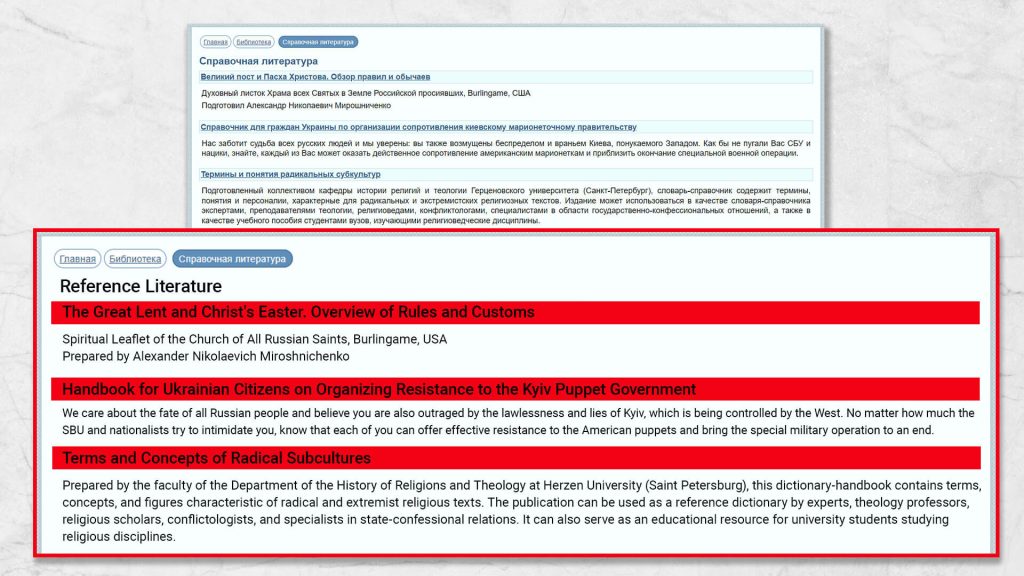


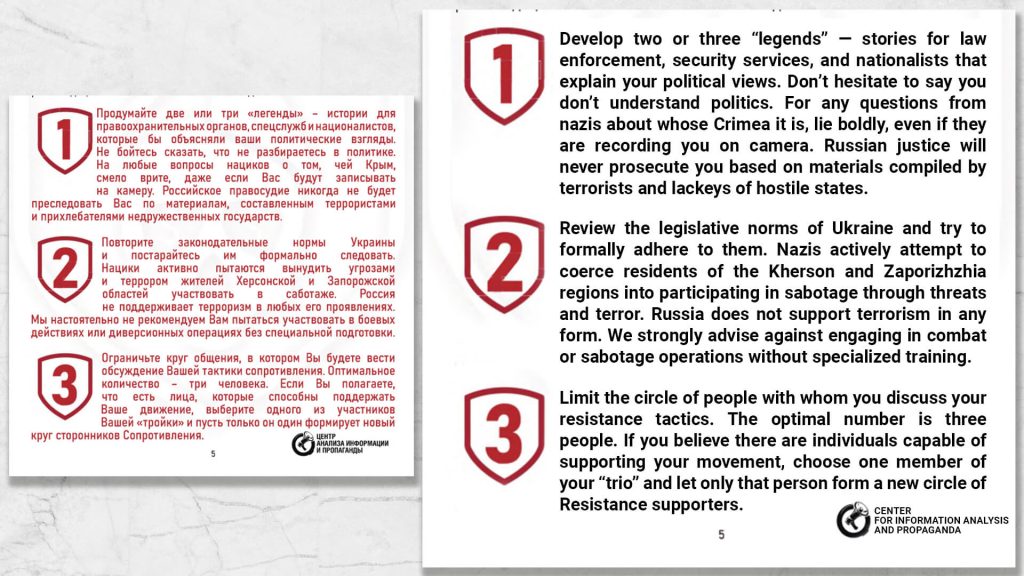
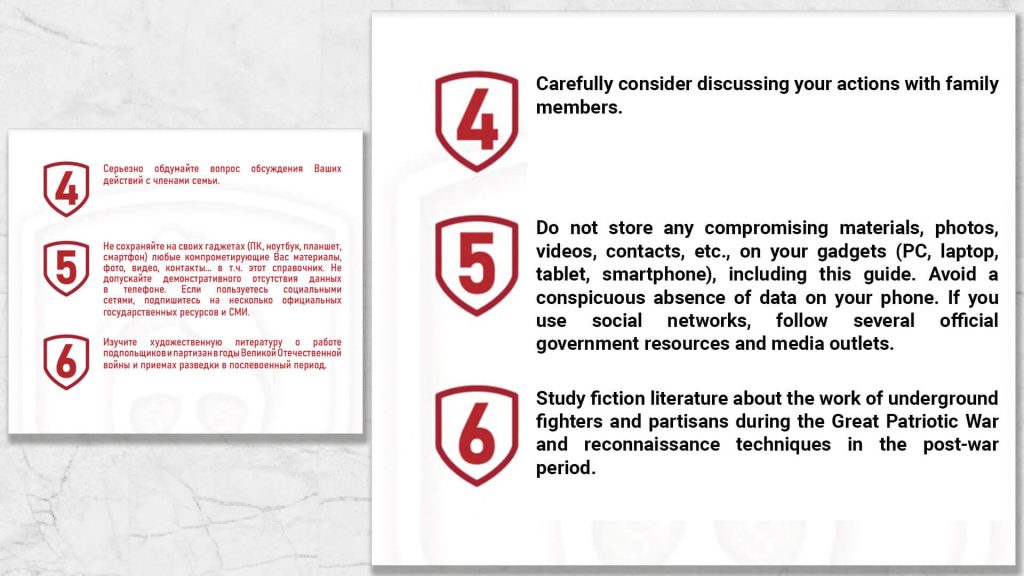
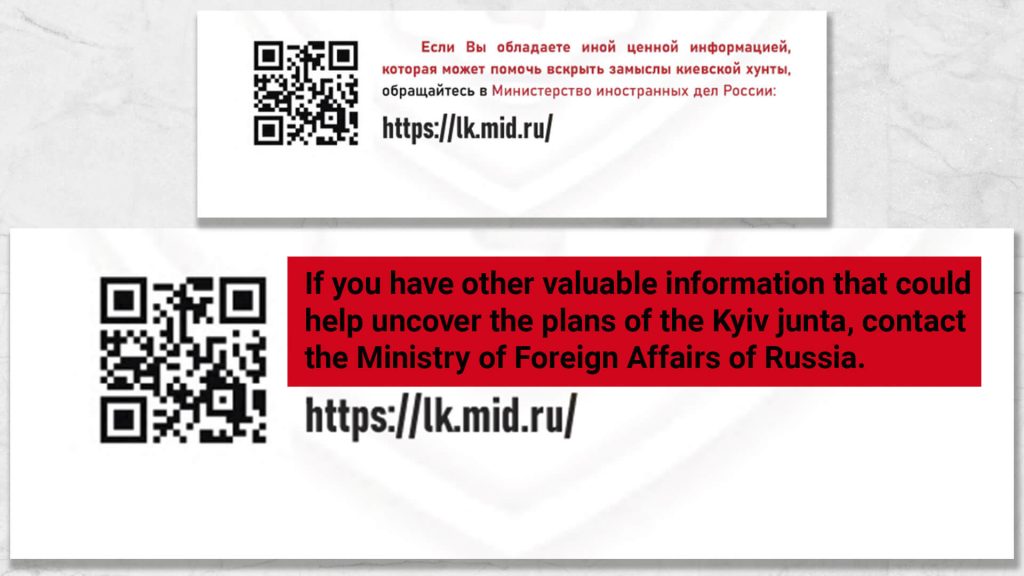

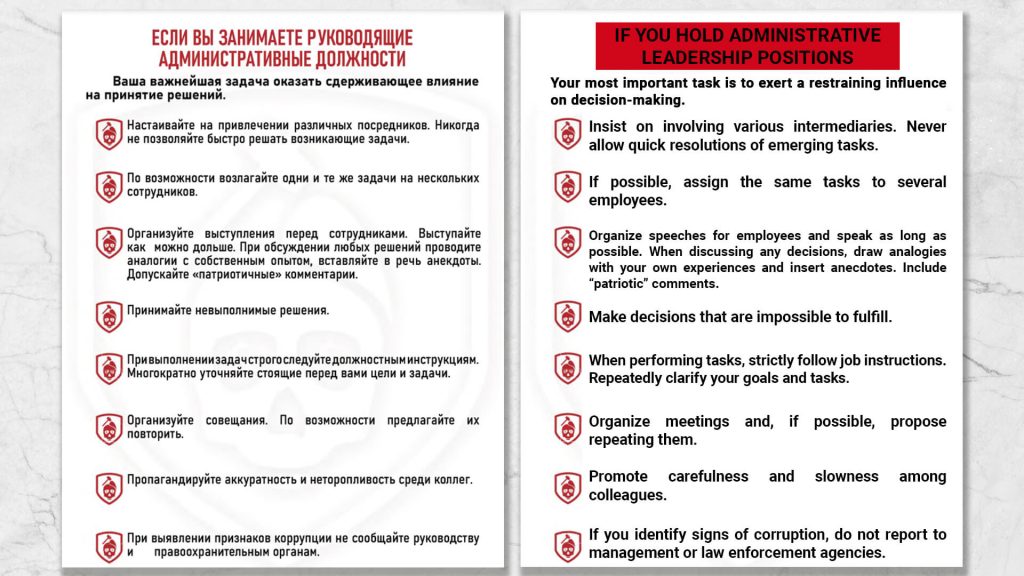

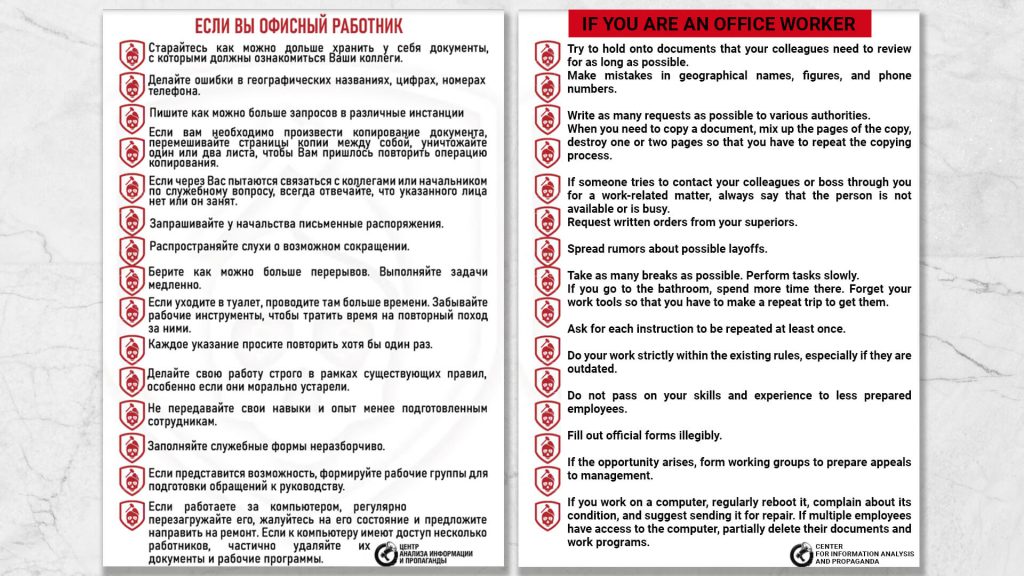


When we first saw this manual on conducting sabotage in Ukraine, published on the websites of the dioceses of the Russian Orthodox Church (ROC), there was still a glimmer of hope that the sabotage promoted by RACIRS agents was more theoretical than practical. However, a more sober reflection on the events of recent years in Ukraine and Russia reveals the extent and scale of their agent network’s inflitration across all layers of the population in Ukraine, within the information space, among journalists, educators, military personnel, law enforcement, clergy, and even across all branches of government: legislative, executive, and judicial.
It is worth noting the ban on the UOC in Ukraine in August 2024 (Law No. 3894-IX).
The title of this law is more general—”On the Protection of the Constitutional Order in the Field of Activities of Religious Organizations” — but its effects primarily concern the activities of the UOC. The final version of the law includes a nine-month transitional period, during which the UOC is given time to sever ties with the ROC and merge into the OCU. But will that have any effect? And will it affect the anti-cult activities of former UOC priests in the new OCU? From the beginning of the full-scale invasion (February 2022) until spring 2024, only 685 out of 8,782 churches of the UOC operating in Ukraine transitioned to the OCU 37. Moreover, the very fact of transitioning to the OCU does not guarantee that the former anti-cult agents from RACIRS will not remain there and continue their activities, just as there’s no guarantee that they’re not still there. As we see on the example of the UGCC, anti-cultists willingly support any political situation, even one that opposes their goals, while simultaneously engaging in covert sabotage against their own country. No denomination or religion in the world has yet withstood the anti-cult plague.
Conclusion
A review of the growing RACIRS agent network in Ukraine over the past 24 years reveals a clear pattern: any government, country, religion, or confession is ultimately subservient to the agents of global anticultism. The Bolsheviks and National Socialists of the past could not resist them, and neither could modern Russia with its inherent pride and imperialism. In fact, Russia has become a stronghold for their associates. Likewise, free-spirited Ukraine and democratic Europe have failed to resist them. Moreover, since 1993, anti-cult agents have been infiltrating and conducting destructive activities in the United States — the bastion of the democratic world. Global anti-cultism is a force that pits nations against each other, spilling innocent children’s blood. Its actions are systematic and inconspicuous, as they were gradually implemented over many years according to a pre-arranged scenario. Until recently, all crimes committed by anti-cult agents went unpunished. However, in July 2024, “The Impact” documentary exposed the true culprit of suffering and long-standing anguish of humanity. The world learned the truth. Now, it is up to each of us to determine how soon we will stop this accelerating mechanism of destructive impact that is killing our children daily. You must ask yourself this question before the plague of anti-cultism knocks on your door.
First they came for the socialists, and I did not speak out —
Because I was not a socialist.
Then they came for the trade unionists, and I did not speak out —
Because I was not a trade unionist.
Then they came for the Jews, and I did not speak out —
Because I was not a Jew.
Then they came for me—and there was no one left to speak for me.
Martin Niemöller (1892–1984)
Source:
- www.apologet.in.ua
- https://orthodoxy.org.ua/
- https://orthodoxy.org.ua/term/apologeticheskiy-centr
- https://web.archive.org/web/20211019015709/https://orthodoxy.org.ua/term/apologeticheskiy-centr
- https://vk.com/apologet_centr
- https://spzh.live//ru/news/46649-v-upts-razrabotali-rekomendatsii-po-protivodeystviyu-destruktivnym-kultam-
- https://www.molodost.in.ua/en/other/apologeticheskie-vstrechi/
- https://ukrsekta.info/2304-o-formirovanii-molodezhnogo-apologeticheskogo-dvizheniya.html
- https://ukrsekta.info/
- https://ukrsekta.info/news/2298-pravoslavie-v-ukraine-aktualnost-sovremennoj-apologetiki.html
- https://ukrsekta.info/2299-ob-ocenke-zarubezhnogo-opyta-gosudarstvennoj-differenciacii-kulturnogo-vklada-religioznyx-tradicij.html
- https://ukrsekta.info/2300-koncepciya-apologeticheskogo-sluzheniya-v-sovremennom-ukrainskom-pravoslavii.html
- www.npar.ru/wp-content/uploads/2016/02/%E2%84%963_2001.pdf (p. 57-58)
- https://www.lsl.lviv.ua/wp-content/uploads/Zb/NDI2012/JRN/PDF/29.pdf
- https://germanhistorydocs.org/en/nazi-germany-1933-1945/protestant-church-leaders-respond-to-the-july-20-1944-assassination-attempt-july-30-1944
- https://anticekta.ru/?page_id=50
- https://podrobnosti.ua/442665-tserkov-nazvala-samye-opasnye-religioznye-sekty-ukrainy.html
- https://zn.ua/SOCIUM/episkop_upts_nazval_naibolee_opasnye_sekty_ukrainy.html
- https://cripo.com.ua/opinion/p-22801/
- https://www.historians.in.ua/index.php/en/doslidzhennya/2652-margarita-kucherenko-sektantstvo-u-radyanskikh-antireligijnikh-zhurnalakh-1920-kh-pochatku-1940-kh-rokiv
- https://www.academia.edu/21732719/Freedom_of_Religion_or_Belief_Anti_Sect_Movements_and_State_Neutrality_A_Case_Study_FECRIS (p. 284)
- http://sectes-info.com/wp-content/uploads/2020/03/dvorking-READ-EN.pdf
- https://novosti-n.org/ukraine_articles/Opasnie-sekti-Ukrayni-1052
- https://www.fecris.org/uncategorized/participants-to-the-conference/
- https://www.fecris.org/uncategorized/abstract-yevgeniy-volkov/
- https://evolkov.net/cults/help/anticult.help.html#gsc.tab=0
- https://www.umoloda.kiev.ua/number/2124/161/75706/
- https://evolkov.net/cults/confsem/totalit.sects.NN.2001.html
- https://bitterwinter.org/scandal-fecris-falsifies-the-program-of-a-2017-conference-to-hide-that-a-fanatic-anti-ukrainian-russian-lawyer-was-among-the-speakers/
- https://svitogliad.com/articles/yakshho-nemaye-svobody-virospovidannya-to-vsi-inshi-svobody-ne-potribni-religiyeznavyczya
- http://publication.pravo.gov.ru/Document/View/0001202005290036
- http://www.kremlin.ru/acts/bank/45555/page/1
- https://www.ansobor.ru/news.php?news_id=10669
- https://www.president.gov.ua/documents/1672020-33561
- https://www.ansobor.ru/library.php?book=85
- https://www.ansobor.ru/userfiles/files/library/pdf/Spravochnik.pdf
- https://opendatabot.ua/ru/analytics/russian-church-2024-4

